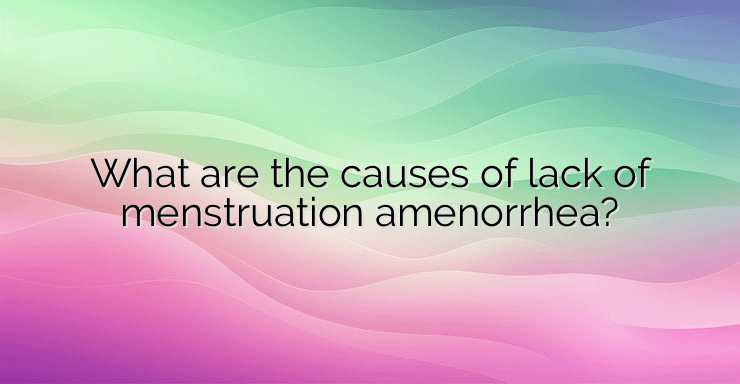Amenorrhea means the absence of menstruation in a woman of childbearing age. Absence of menstruation is natural during pregnancy, breastfeeding or menopause. Outside of these situations, amenorrhea can be a sign of chronic stress, anorexia, or thyroid dysfunction. Types of amenorrhea Primary amenorrhea – during puberty, it is possible for the menstrual cycle to be irregular or to occur later, even if the secondary sexual characteristics have developed. Secondary amenorrhea – cessation of menstruation for a period of time in women of childbearing age who previously had regular menstruation. Causes Pregnancy Pregnancy is a cause of secondary amenorrhea and should be observed in sexually active women. However, some therapeutic agents that are used to treat amenorrhea are contraindicated during pregnancy, so it is important to determine the cause of amenorrhea before proceeding with treatment. Delayed puberty This is the most common cause of primary amenorrhea. The age of onset of puberty is usually between 11 and 13 years, but can vary widely. In developed countries, delayed puberty is common in young girls who are very thin or athletic. This is due to the low amount of body fat, which does not allow the production of estrogens. Estrogen allows the uterine wall to thicken and menstruation to occur if the egg was not fertilized by a sperm at the time of ovulation. In the presence of developed birthmarks, without the onset of menstruation, the delay is most likely due to low body weight and lack of estrogen. If the birthmarks are not yet developed at the age of 14, chromosomal and hormonal abnormalities, as well as disorders of sexual development, should be suspected. Breast-feeding During breast-feeding, it is possible to have a disturbance in the menstrual cycle. However, while breastfeeding, women continue to ovulate. Breastfeeding can stop ovulation and prevent pregnancy when the baby is less than 6 months old and is exclusively breastfed. Menopause Menopause is the natural cessation of the menstrual cycle in women between the ages of 45 and 55. Estrogen production gradually decreases, leading to irregular periods. Ovulation may occur sporadically for up to two years after menstruation stops. Hormonal contraception When you stop taking contraceptives, it may take several months for the normal cycle of ovulation and menstruation to resume. This is called postcontraceptive amenorrhea. Hormonal contraceptives reproduce the hormonal state of pregnancy and therefore can stop the menstrual cycle. It may take some time for the normal menstrual cycle to return. This is more common in women who had very long (more than 35 days) and irregular menstrual cycles before taking contraceptives.Postcontraceptive amenorrhea does not cause subsequent fertility disorders. Stress Psychogenic amenorrhea is the result of psychological stress. This can temporarily disrupt the functioning of the hypothalamus and cause menstruation to stop while the stress continues. Weight loss and eating disorders Being too low in body weight can lead to a drop in estrogen production and the cessation of menstruation. In the majority of women who suffer from anorexia or bulimia, menstrual disorders occur. Intense physical activity and low-calorie diets are stressful for the body, which can lead to hormonal imbalance and amenorrhea. Excessive secretion of prolactin from the pituitary gland Prolactin is a hormone that promotes the growth of the mammary glands and lactation. Excess secretion of prolactin by the pituitary gland can be caused by a small tumor, which is usually benign, or by certain medications, such as antidepressants. Other causes Obesity or overweight; Taking certain medications such as oral corticosteroids, antidepressants, antipsychotics, or chemotherapy; Scarring of the uterus – after surgery to treat uterine fibroids, endometrial resection or caesarean section, there may be a significant decrease in menstruation or even temporary or prolonged amenorrhea; Abnormality in the development of the genitals of non-genetic origin. Chronic and endocrine diseases Ovarian tumor, polycystic ovary syndrome, hyperthyroidism, hypothyroidism; Chronic diseases that are accompanied by significant weight loss – tuberculosis, cancer, rheumatoid arthritis. References: https://www.passeportsante.net/fr/Maux/Problemes/Fiche.aspx?doc=amenorrhee_pmresection of the endometrium or caesarean section may have a significant decrease in menstruation or even temporary or prolonged amenorrhea; Abnormality in the development of the genitals of non-genetic origin. Chronic and endocrine diseases Ovarian tumor, polycystic ovary syndrome, hyperthyroidism, hypothyroidism; Chronic diseases that are accompanied by significant weight loss – tuberculosis, cancer, rheumatoid arthritis. References: https://www.passeportsante.net/fr/Maux/Problemes/Fiche.aspx?doc=amenorrhee_pmresection of the endometrium or caesarean section may have a significant decrease in menstruation or even temporary or prolonged amenorrhea; Abnormality in the development of the genitals of non-genetic origin. Chronic and endocrine diseases Ovarian tumor, polycystic ovary syndrome, hyperthyroidism, hypothyroidism; Chronic diseases that are accompanied by significant weight loss – tuberculosis, cancer, rheumatoid arthritis. References: https://www.passeportsante.net/fr/Maux/Problemes/Fiche.aspx?doc=amenorrhee_pm


Leave a Reply